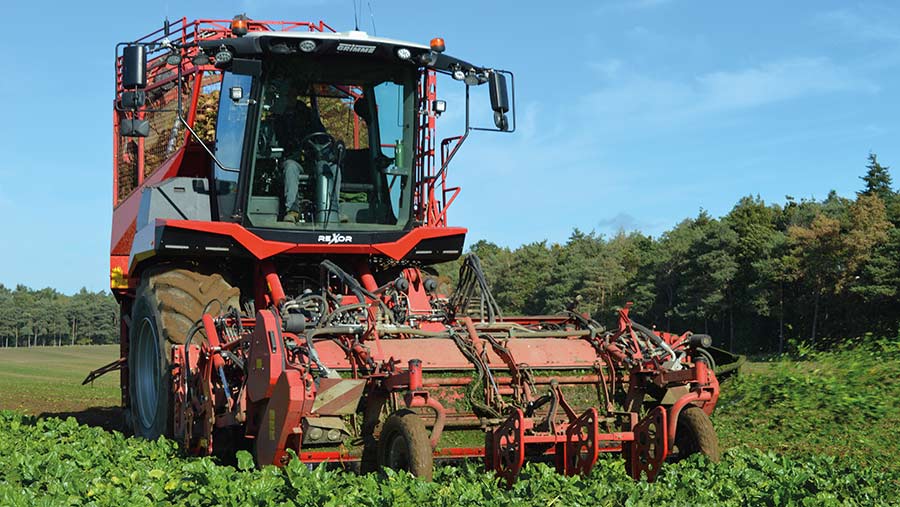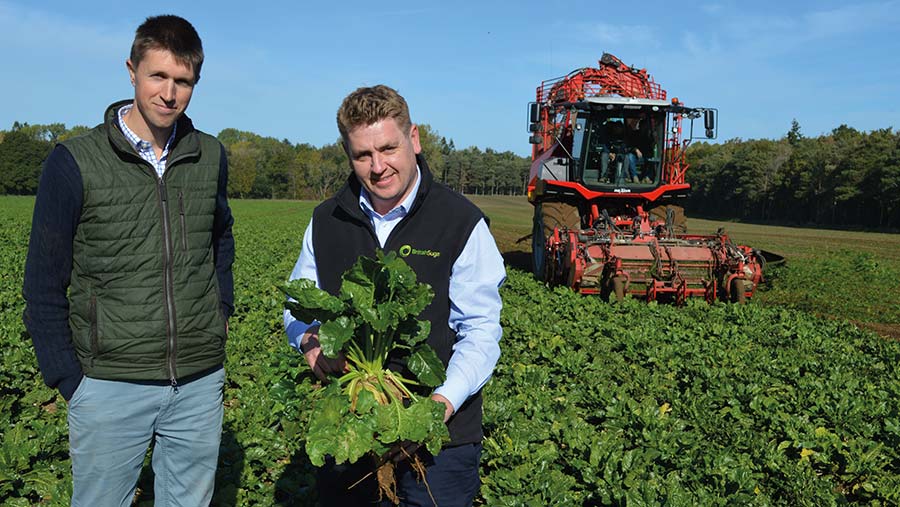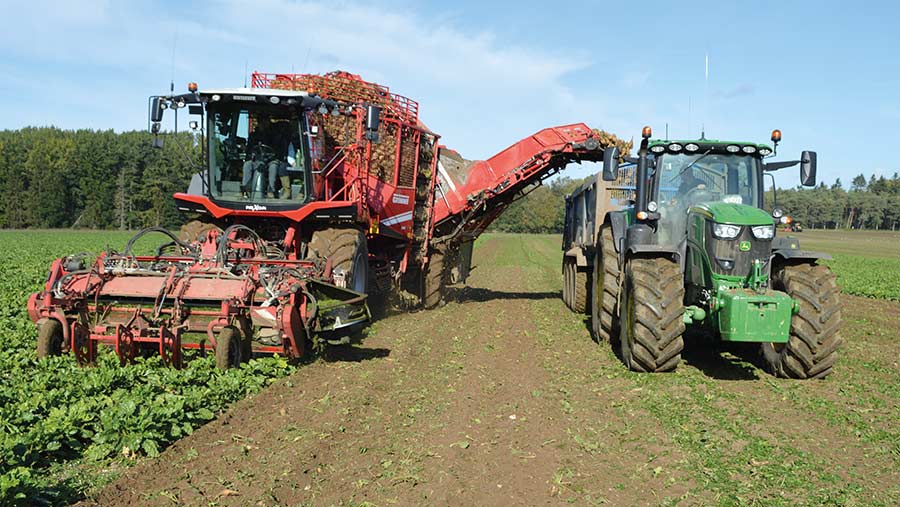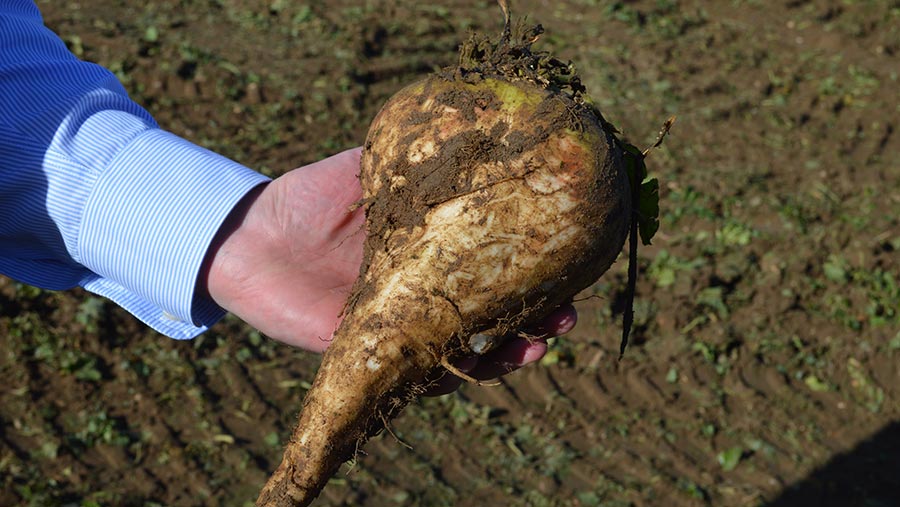Drought-hit early sugar beet yields not as bad as feared
 Harvesting in Norfolk © MAG/David Jones
Harvesting in Norfolk © MAG/David Jones Early sugar beet yields are better than first feared, with a wide range of yields being reported across eastern England, after a spring and summer drought restricted root growth.
Beet yields are clearly down on last year’s average of just over 80t/ha, but not the disaster some growers dreaded after rain around the August bank holiday weekend rescued some hard-pressed drought-stressed crops.
Andrew Peal, farm manager at Salle Farming in Norfolk, who together with two other large nearby estates lift 850ha of sugar beet annually with a shared harvester, says crops suffered from very little rain from spring drilling to late August.
See also: Strip-tilling sugar beet – two growers’ experiences

Andrew Peal and Nick Morris © MAG/David Jones
Early harvested yields
Early yields are down at Salle, some 10 miles north-west of Norwich, which grows 330ha of beet on its land and across three contracted farms and where its five-year average beet yield is an impressive 90t/ha plus.
“Yields are better than we feared, but we await final yields from completed fields. We had adjusted budgeted yields in the summer down to 70t/ha due to the dry weather,” he tells Farmers Weekly.
He has lifted more than a quarter of the farm’s crop on its heavier soils on which winter wheat will be drilled after the sugar beet.
British Sugar’s head of central agriculture, Nick Morris, estimates that about 5-10% of the national beet crop has been lifted, with high yields seen in the rich deep south Lincolnshire silts while poorer yields have come from light, freely draining sands.
“We are seeing a lot of variability from a number of lifts including yields of more than 100t/ha to yields below 50t/ha,” he says.
Last season’s sugar beet crop from more than 3,000 English growers stretching from Yorkshire down to Essex showed an average yield of 81.1t/ha, above the national five-year average of 75.6t/ha, across 91,000ha producing a crop of 1.03m tonnes of sugar.

The sugar beet harvest in Norfolk © MAG/David Jones
Low yields, high sugars
British Sugar’s weekly digs in August over 500 fields had highlighted lower yields, but with sugar content above 20% as the level of sugar had been concentrated in the small beets.
Salle is seeing sugar contents this harvest at 16%, probably diluted after the August rain had boosted growth, but this level is likely to rise through the lifting season into November to come close to last season’s average of 16.5%.
Mr Morris says with more rain in the Newark and Wissington factory areas, sugars were just over 16.5%, but in the drier conditions seen in the Bury St Edmunds area sugars were 18%, compared to an average of 17.5% nationally for early liftings in previous years.
Newark in Nottinghamshire was the first of British Sugar’s four factories to open on 19 September, followed by its biggest plant at Wissington in West Norfolk on 26 September, while its other two factories delayed their openings as these areas received less rain.
Therefore, Bury St Edmunds in Suffolk opened on 5 October and finally Cantley in east Norfolk is set to open on 20 October to allow more time for the crop to benefit from any late rain and so improve overall yields.

© MAG/David Jones
Cover crops
Sugar beet growing at Salle starts with an over-wintered cover crop, containing such species as phacelia and fodder radish, which is sprayed off with glyphosate before Christmas, cultivated in early April, then two days later shallow cultivated and drilled.
Establishment was difficult last spring with some seeds germinating and then being up and away quickly, while other plants struggled to establish in the very dry weather, and the crop was slow to put on bulk through the summer, and only saved by the rains at the end of August.
With a large area of flowering cover crops grown across the farm, no neonicotinoid insecticide seed dressings were used, and so with aphid levels high the crop received three insecticide sprays to control the aphid-spread virus yellows disease.
Neonicotinoid seed treatments were banned in sugar beet in 2018 due to concerns that they may kill bees and other pollinators, and were not used in the springs of 2019, 2020 and 2021, but the use of the neonicotinoid Cruiser (thiamethoxam) seed dressing was given the green light for emergency temporary use in 2022.
The threat of the aphid-borne virus yellows disease this season as monitored by Rothamsted triggered the clearance to use neonicotinoid seed dressings if growers request them.
This came after heavy infestations of virus-carrying peach-potato aphids (myzus persicae) occurred in 2020, leading to a sharp 25% fall in national beet yields.
Flowering crops
If neonicotinoid seed treatments are used, no flowering crops can be grown in the 32 months after the beet is drilled, thus precluding crops such as oilseed rape, beans and also cover crop mixtures
Sugar beet at Salle is often followed by winter wheat or spring barley, and both crops in turn are followed by a cover crop which precluded the use of the seed dressing.
Salle used three application of three different foliar sprays in the season to control the aphids – one application of Teppeki (flonicamid), one of InSyst (acetamiprid) and one of Movento (spirotetramat), the latter granted an emergency authorisation for this season.
Salle, with 2,000ha of total arable cropping, together with fellow Holkham and Raynham estates, combine their resources to hire a six-row Grimme Rexor self-propelled harvester to lift their combined 850ha of beet, and good progress was being made in the current dry weather.
Sugar beet growers received the welcome news this summer that British Sugar would increase its beet price for next season’s crop’s by 48% to £40/t from £27/t this season, to help offset the higher prices of key inputs such as fertiliser and fuel.
“The higher price makes sugar beet a real contender in the rotation and we are likely to keep a similar area next year to maintain a sustainable rotation on the farm,” says Mr Peal.
British Sugar says the rise reflected the higher input costs faced by growers, the rise in the price of competing crops such as wheat and oilseed rape, and also to give growers confidence to invest for the future.
“We want to build the area back up to 95,000ha in 2023 and we are on target to achieve this aim,” says Mr Morris.
UK sugar beet harvests |
|||
| Year | White sugar production | Average beet yield | Sugar beet area |
| 2019 | 1.19m t | 80.65t/ha | 100,000ha |
| 2020 | 900,000t | 59.15t/ha | 103,000ha |
| 2021 | 1.03m t | 81.1t/ha | 91,000ha |
| 2022 | n/a | n/a | still to be confirmed |
| Note: The five-year average national beet yield is 75.6t/ha. The record crop of 1.45m tonnes of white sugar was harvested in 2014. | |||

